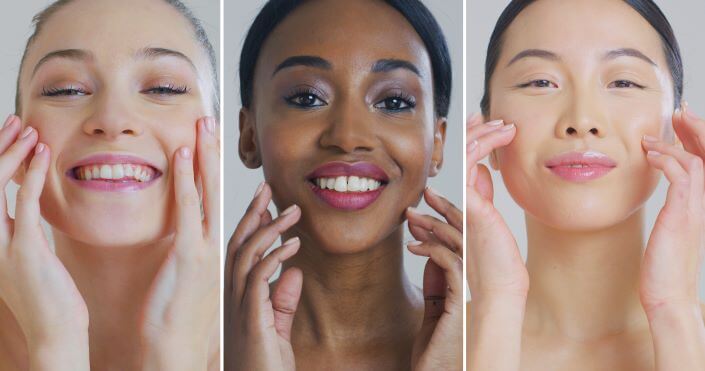We are all creatures of habit, and developing the right habits can significantly impact the quality of our day-to-day lives. According to Dr. Ashley DiLorenzo of U.S. Dermatology Partners in Silver Spring and Rockville, Maryland, “Studies show it takes a month to build a new habit into your daily routine. If you’re trying to get healthier skin, that means you need to make time to develop some good skincare habits. We’ll walk through some of the best habits for healthy skin in this blog. I recommend taking them on one at a time and apply them consistently for at least a month. You’ll be surprised by the results!” Keep reading to explore the ten habits shared by people with great skin.
1 – They Know Their ABCs
Knowing what different products do is an important first step in getting your skin looking its best. A great starting place is to learn the ABCs:
- A – Antioxidants – These products prevent damage from photoaging, sun damage, pollutants, and other irritants.
- B – Barriers – These products place a physical barrier between the skin and sunlight, chemicals, oils, debris, allergens, and other environmental elements that can damage the skin.
- C – Vitamin C – Using products that contain vitamin C and consuming vitamin C in the diet boots collagen production as well as preventing and addressing the signs of aging, especially fine lines, wrinkles, and dark spots caused by UV damage.
2 – They Protect Skin from the Sun
According to Dr. DiLorenzo, “If you only do one thing every day, it should be putting on sunscreen. The negative consequences – both short and long term – of sun damage are myriad. From sunburns to skin cancer, the sun’s UVA and UVB rays are dangerous. It’s essential to apply a broad-spectrum sunscreen with a sun protection factor (SPF) of at least 30 every day and reapply every 2 hours when in the sun. You should also limit your sun exposure whenever possible, especially between 10 am and 4 pm when the sun’s rays are most damaging. For situations where extended exposure is unavoidable, you should wear protective clothing such as wide-brimmed hats and long sleeve shirts.”
3 – They Know Beauty Sleep Is Real & Necessary
Inadequate sleep raises cortisol levels. Cortisol causes inflammation, like when your eyes and face look puffy from lack of sleep. Inflamed skin is at a greater risk for the development of flare-ups in chronic conditions like acne, eczema, psoriasis, and rosacea. Chronic inflammation can also lead to accelerated signs of aging, including the development of fine lines and wrinkles.
4 – They Stay Hydrated
Applying moisturizers is an essential part of any skincare routine, but skin hydration starts from the inside out. It’s essential to drink plenty of water to stay hydrated. This makes skin cells healthier, more resilient, and better looking. You should be drinking at least eight glasses of water every day. Keep in mind that the skin receives water after all the other bodily organs and systems, so the more water you take in, the more water gets to your skin.
5 – They Eat a Nutrient-Rich Diet
Like staying hydrated, giving your body the nutrients it needs to maintain health can help to ensure your skin receives adequate nutrition to look and feel its best. While the skin health connections between consuming specific foods are dubious at best, consuming a nutrient-rich diet is undoubtedly important. Because the skin receives nutrients after other body systems get what they need, the more nutrients in your diet – the better. Everyone’s nutrition needs are different, so work with a physician or dietician to create a dietary plan that works for your needs.
6 – They Get Enough Exercise
Research indicates that 30 minutes of exercise five days per week improves circulation, decreases inflammation and pain, and reduces stress. That translates to good skin health since poor circulation and higher levels of inflammation and stress contribute to skin health concerns like fine lines and wrinkles, flare-ups in chronic skin conditions, and more. Making time for half an hour of exercise can improve overall wellbeing and maximize the results of your skincare routine.
7 – They Create the Right Skincare Routine
According to Dr. DiLorenzo, “Developing a daily skincare routine should include a trip to your dermatologist. Your unique skin type, skin health history, age, and treatment goals need to be taken into account when you design your morning and evening skincare routine.” While you should talk to a dermatologist to map out the specifics, you can explore a good basic morning and evening skincare routine below.
Basic Morning Skincare Routine
Morning skincare routines are about protection. Your skin can come into contact with sunlight, pollutants, allergens, and other environmental irritants throughout the day, so you want to keep it safe and healthy. Your dermatologist can help you find the exact products for your skin, but your basic routine should include the following:
- Gentle cleansing – Wash your face using a gentle cleansing product and warm water. The goal is to remove any debris without unnecessarily stripping the skin of moisture and natural oils. Be gentle as you clean the skin. Don’t scrub or tug, which can irritate the skin, cause inflammation, and has been linked to premature signs of aging.
- Apply treatments – After washing, the pores are open and ready to absorb products, so this is the ideal time to apply skincare products like toner, serums, anti-aging creams, and treatments for chronic skin conditions. Allow these products time to fully absorb before going to the next step.
- Moisturize – Applying moisturizer helps keep skin looking supple and healthy, and it helps to treat concerns like irritation, dryness, and cracking. During spring and summer, the air likely has more humidity, so a lighter moisturizer will do the trick. During the drier fall and winter months, you may want to use a thicker, cream-based moisturizer. Your dermatologist often has samples in the office to help find the best fit for you.
- Use sunscreen – Every day, you should apply a broad-spectrum (protecting from UVA and UVB rays) sunscreen to any part of the body that will be exposed to the sun, including the face, neck, and hands.
Basic Nighttime Skincare Routine
Nighttime skincare routines are focused on hydration and repair. It’s time to undo the damaging effects of the day. Basic nighttime skincare steps include:
- Gentle cleansing – If you wear makeup, use a makeup remover to take off your cosmetics without the need to scrub your skin aggressively. Then, follow up with your gentle cleanser and rinse with warm water.
- Exfoliate periodically – Unless you have easily irritated skin or a chronic condition like eczema, you should use an exfoliant a few times a week to promote cell turnover.
- Apply treatments – Once the skin is clean and/or exfoliated, it’s ready to absorb those treatments. Nighttime treatments should be aimed at healing and hydrating.
- Moisturizer – Once your treatments are fully absorbed, use a quality, cream-based moisturizer to protect, repair, and hydrate overnight. You should also apply a night cream to sensitive areas like the skin around the eyes.
8 – They Perform Regular Skin Self-Exams
According to Dr. DiLorenzo, “Regular self-exams are really important. They help to minimize the risk for serious and advanced forms of skin cancer when people notice and report early indicators to their dermatologist. Regular self-exams can help you become more familiar with your skin, so you know right away if there are changes, ensuring you can work with a dermatologist at the first signs that something may be wrong.”
Your skin self-exam doesn’t need to be complicated. Simply choose a room with good lighting and a full-length mirror. You’ll need a hand mirror as well to see the back of your body. Starting with the scalp, examine every inch of the body and carefully note any spots or irregularities. Take special note of any areas that have changed since your last self-exam. If you’re concerned about a particular spot, it’s often helpful to take a photo to compare to in few months. While any changes may be indications that something is wrong, it’s especially important to let your dermatologist know if you notice the ABCDE’s of skin cancer:
- A – Asymmetry – a spot that is uneven on one side
- B – Border – a spot with an irregularly shaped border
- C – Color – a spot that is a different color from similar marks or has many colors within it
- D – Diameter – a spot that is bigger around than a pencil eraser
- E – Evolution – a spot that is changing quickly
9 – They Manage Chronic Skin Conditions
If you have a chronic skin condition, like acne, eczema, rosacea, or psoriasis, you should have a plan to prevent or minimize flare-ups and keep your skin healthy. This includes partnering with a dermatologist to find the best skincare products, avoid triggers, and receive treatments or take medications as directed by your dermatologist to manage your condition.
10 – They Visit a Dermatologist for an Annual Exam
In addition to completing your regular skin self-exams, you should visit your dermatologist annually (or at the appropriate interval selected specifically for you by your dermatologist) for a professional skin exam. At these checkup visits, the dermatologist will examine your skin for any areas of concern, answer questions you have about skincare, and generally, partner with you to achieve and maintain your healthiest skin and minimize the risk for serious issues like skin cancer. If it’s time for your annual checkup, the U.S. Dermatology Partners team would love to hear from you. Get started any time by filling out our online scheduling request.
Find a location near me
or


